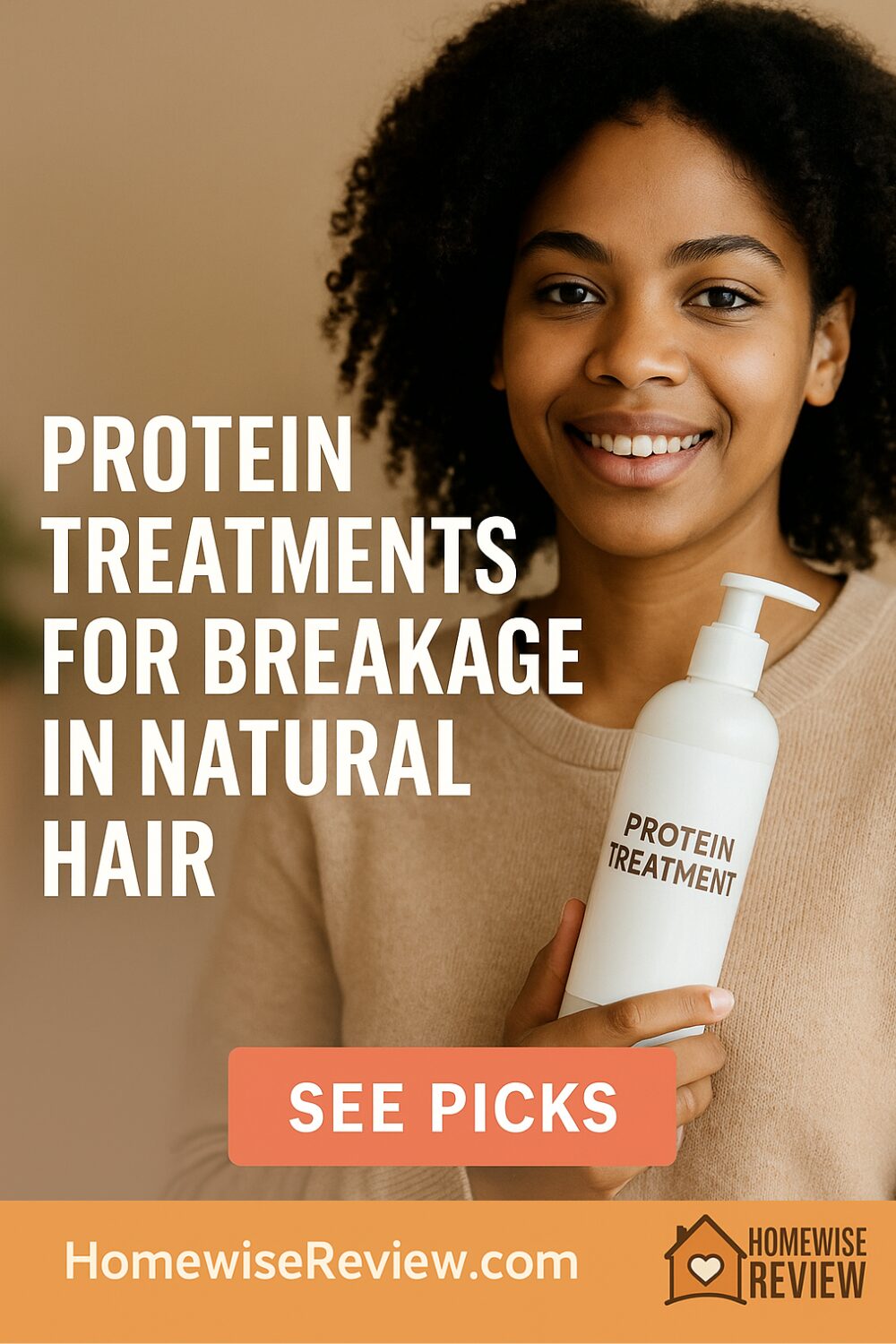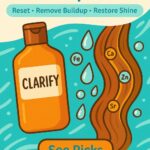
Breakage sneaks up when curls feel soft on day one but snap during detangling, shed in short bits, and look frayed at the ends. Natural hair is beautiful and resilient, yet tight curl patterns bend more often along the strand. That bend can expose weak spots, especially if you color, heat style, or use lots of gels and edge control. A good protein treatment supports the cuticle so coils clump instead of fray, and detangling becomes smoother with fewer snapped ends.
Not every “protein” works the same way. Hydrolyzed proteins and amino acids can temporarily patch weak spots so hair feels stronger and holds moisture better. Bond builders focus on internal bonds that fatigue with heat, color, and mechanical wear. The sweet spot is balance. Too much strength can feel stiff and brittle, while too little leaves hair gummy and stretchy. Below are four options that owners and stylists reach for when breakage is the main complaint.
Quick Comparison
| Pick | Why it helps breakage | Protein or bond type | Best for |
|---|---|---|---|
| Aphogee Two-Step Protein Treatment | Intense reinforcement that reduces snap and split-prone ends after heavy damage | Hydrolyzed collagen and keratin blend | Severe breakage after color, heat, or long protective styles |
| Olaplex No. 3 Hair Perfector | Restores internal bonds so curls feel springy again and shed less during detangle | Bond builder (bis-aminopropyl diglycol dimaleate) | Color-treated or heat-stressed curls that feel limp or too stretchy |
| SheaMoisture Jamaican Black Castor Oil Strengthen & Restore Masque | Weekly strength with slip so breakage drops without stiffness | Hydrolyzed keratin + nourishing oils and butters | Dry, high-shrinkage coils that tangle and snap mid-shaft |
| Mielle Rosemary Mint Strengthening Hair Masque | Balanced protein and hydration to reduce shed knots and improve curl hold | Amino acids + hydrolyzed proteins | Dense, tangle-prone natural hair that needs routine reinforcement |
Deep Dives
Aphogee Two-Step Protein Treatment
What it is: A salon-style hard protein service packaged for at-home use. Step 1 deposits a concentrated protein film that stiffens as it dries. Step 2 is a pH-balanced conditioner that softens and seals.
Why it helps breakage: The high protein load temporarily fills weak areas along the cuticle so hair resists mechanical stress. Owners often report fewer snapped ends and stronger set styles for several weeks after use.
Best fit: Severe breakage after bleach or color, heat mishaps, or long protective styles where shed hair and buildup hid weak spots. Coarse strands that can handle strong treatments respond especially well.
How to use: Work on clean, detangled hair in sections. Apply Step 1 and sit under a hooded dryer until hair is hard and dry to the touch. Do not manipulate during the hard stage. Rinse thoroughly with lukewarm water, then apply the balancing conditioner and rinse again. Follow with a rich mask if needed.
Keep in mind: Limit to every 4 to 6 weeks. Pair with weekly moisture masks to avoid stiffness. Fine or low-porosity hair should start with shorter processing times.
Pairing tips: Use a chelating or clarifying shampoo before treatment if you use edge control or heavy gels. Follow the service with a no-heat week to lock in benefits.
Olaplex No. 3 Hair Perfector
What it is: A pre-shampoo bond builder that targets internal bonds weakened by color, heat, and daily wear. It is not a protein, but it complements protein by restoring elasticity.
Why it helps breakage: By improving internal bonding, curls rebound instead of stretching and snapping. Owners notice less hair left in the comb and better curl spring after two to three weekly uses.
Best fit: Color-treated curls that feel mushy or overly stretchy. Great for those who heat style periodically and want to maintain elasticity between color appointments.
How to use: Apply to damp, clean hair from roots to ends. Comb through for even coverage. Leave on for at least 10 minutes. Rinse, then follow with shampoo and a moisturizing conditioner or mask.
Keep in mind: Use once or twice a week until elasticity improves, then taper to maintenance. If hair feels stiff after adding protein elsewhere in your routine, lean on this instead for a few weeks.
Pairing tips: Alternate with your weekly protein mask. Bond building plus light protein often beats either alone.
SheaMoisture Jamaican Black Castor Oil Strengthen & Restore Masque
What it is: A weekly strengthening mask with hydrolyzed keratin, conditioning polymers, and rich emollients like shea butter and castor oil for slip.
Why it helps breakage: The protein supports the cuticle while oils reduce friction so shed knots do not snowball into snaps. Many owners see better clumping and fewer broken flyaways after two or three uses.
Best fit: Coils that tangle easily and feel rough after washing. Works well for twist-outs and braid-outs that need hold without crispiness.
How to use: After shampoo, squeeze out excess water and apply generously in sections from mid-lengths to ends. Detangle with fingers or a wide-tooth comb. Leave on 10 to 15 minutes with a cap or gentle heat, then rinse.
Keep in mind: If hair is very fine, apply mid-length to ends only to avoid root heaviness. Rotate with a pure moisture mask during weeks when hair feels stiff.
Pairing tips: Seal ends with a light oil while hair is damp. Combine with a heat protectant on styling days to protect fresh gains.
Mielle Rosemary Mint Strengthening Hair Masque
What it is: A balanced weekly mask that mixes amino acids and hydrolyzed proteins with humectants and botanicals for a stronger, smoother finish.
Why it helps breakage: The light protein blend reduces stretch while humectants keep strands flexible. Owners highlight easier detangling and less mid-shaft snapping, especially on dense, type 3–4 textures.
Best fit: Natural hair that needs a steady, moderate dose of strength without the intensity of a hard protein service.
How to use: Apply after shampoo on damp hair in sections. Work through with extra water to boost slip. Leave on 15 to 20 minutes, preferably under a cap or warm towel, then rinse.
Keep in mind: If you also use strong gels and edge control, clarify or chelate every 1 to 2 weeks to prevent film that can mask results.
Pairing tips: Finish with a lightweight leave-in for glide and a pea-size cream for hold. Avoid stacking multiple protein stylers on the same day.
Do You Need Protein or Moisture?
- You likely need protein if curls feel overly stretchy when wet, sets collapse early, and short broken pieces show up on your shoulders.
- You likely need moisture if hair feels rough and squeaks but snaps less, or if it feels stiff after a protein mask.
- Balanced hair springs back when gently pulled and feels smooth, not gummy or glassy.
A Simple Breakage-Repair Routine
- Clarify or chelate every 1 to 2 weeks if you use heavy stylers or live with hard water.
- Pick one treatment lane this week. Use either a protein mask or a bond builder, not both on the same day.
- Deep condition with a moisture mask on off weeks to keep flexibility.
- Protect the ends with a light oil on damp hair and low-tension styles.
- Heat with intention. Always use a heat protectant and keep passes minimal.
- Trim smart. Dust obvious splits so new strength is not wasted on frayed ends.
Final Thoughts
Protein treatments help natural hair bounce back from breakage by reinforcing the cuticle and improving elasticity. If damage is heavy, Aphogee’s Two-Step is the reset to consider, followed by moisture for balance. When color and heat drain curl spring, Olaplex No. 3 restores bounce without stiffness. For weekly strength that still detangles well, SheaMoisture’s JBCO Masque is a steady workhorse. If you want balanced reinforcement with slip for dense coils, Mielle Rosemary Mint Masque is an easy add. Keep clarifying on a schedule, rotate moisture weeks, and treat ends kindly so gains stack over time.
See Also
If you are rebuilding from breakage, a few companion guides can speed the process. How to Stop Hair Breakage and Split Ends lays out daily habits that protect new growth. If damage came from color or hot tools, Best Heat Protectant for Natural Hair shows what to use before styling. To rebuild strength without stiffness, Best Protein Treatments for Damaged Hair: Strength Without Stiffness compares more options. Follow your treatment with the right base wash using Sulfate Free Shampoos for Natural Hair That Actually Clean and seal progress with a rich rinse-out from Best Conditioner for 4C Hair.
FAQs
How often should I use a protein treatment for breakage?
Start weekly with a moderate mask for four weeks, then reassess. Use strong services like Aphogee every 4 to 6 weeks only.
Can I use a protein treatment and a bond builder on the same day?
You can, but most stylists suggest alternating across weeks to avoid stiffness or over-processing.
What if my hair feels hard after a protein mask?
Follow with a moisture mask or a creamy conditioner, then pause protein for one to two wash cycles.
Will protein treatments fix split ends?
They can improve feel and reduce fray, but only trimming removes true splits.
Do low-porosity curls tolerate protein?
Yes, in moderation. Choose lighter, amino-acid rich formulas and keep processing times shorter.




